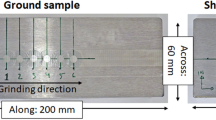Abstract
A systemic experimental investigation involving scanning electron microscopy, Vickers microhardness tester, X-ray diffraction, three-axis piezoelectric dynamometer, and thermocouple was carried out to analyze the affected layers formed in grinding of AISI 52100 steel. The formation mechanisms and properties of affected layer at different grinding conditions were investigated. It is found that the phase transformation, as well as retained austenite and white layer, can be formed at the grinding temperature below the nominal phase transformation temperature of the workpiece material. Mechanical effect associated with plastic deformation also can influence the white layer formation, and play an important role for the phase transformation of the ground workpiece. Furthermore, higher hardness and residual tensile stress are observed on the ground surface of hardened steel, but it shows residual compressive stress on the ground surface of annealed steel.
Similar content being viewed by others
References
Malkin S (1989) Grinding technology: theory and application of machining with abrasives. Ellis Horwood Ltd., Chichester
Akcan S, Shah S, Moylan SP, Chhabra PN, Chandrasekar S, Yang HTY (2002) Formation of white layers in steel by machining and their characteristics. Metall Mater Trans A 33A:1245–1254
Griffiths BJ (1987) Mechanism of white layer generation with reference to machining and deformation processes. Trans ASME J Tribol 109:525–530
Ramesh A, Melkote SN, Allard LF, Riester L, Watkins TR (2005) Analysis of white layers formed in hard turning of AISI 52100 steel. Mater Sci Eng 390A:88–97
Chou YK, Evans CJ (1999) White layers and thermal modeling of hard turned surfaces. Int J Mach Tools Manuf 39:1863–1881
Ranganath S, Guo C, Hegde P (2009) A finite element modeling approach to predicting white layer formation in nickel superalloys. Ann CIRP 58:77–80
Mao C, Zhou ZX, Ren YH, Zhang B (2010) Analysis and FEM simulation of temperature field in wet surface grinding. Mater Manuf Processes 25:399–406
Eda H, Kishi K, Hashimoto S (1981) The formation mechanism of ground white layers. Bulletin of the JSME 24:743–747
Guo YB, Sahni J (2004) A comparative study of hard turned and cylindrically ground white layers. Int J Mach Tools Manuf 44:135–145
Umbrello D, Jawahir IS (2009) Numerical modeling of the influence of process parameters and workpiece hardness on white layer formation in AISI 52100 steel. Int J Adv Manuf Technol 44:955–968
Turley DM (1975) The nature of white-etching surface layers produced during reaming ultra high strength steels. Mater Sci Eng 19:79–86
Cusanelli G, Wyser AH, Bobard F, Demellayer R, Perez R, Flükiger R (2004) Microstructure at submicron scale of the white layer produced by EDM technique. J Mater Process Technol 149:289–295
Kruth P, Stevens L, Froyec L, Lauwers B (1995) Study of the white layer of a surface machined by die-sinking electro-discharge machining. Annals CIRP 44:169–172
Lojkowski W, Djahanabakhsh M, Bürkle G, Gierlotka S, Zielinski W, Fecht HJ (2001) Nanostructure formation on the surface of railway tracks. Mater Sci Eng 303A:197–208
Baumann G, Fecht HJ, Liebelt S (1996) Formation of white-etching layers on rail treads. Wear 191:133–140
Becker PC (1981) Microstructural changes around non-metallic inclusions caused by rolling-contact fatigue of ball bearing steels. Met Technol 6:234–243
Yang YY, Fang HS, Huang WG (1996) A study on wear resistance of the white layer. Tribol Int 29:425–428
Tomlinson WJ, Blunt LA, Spraggett S (1988) Running-in wear of white layers formed on EN24 steel by centreless grinding. Wear 129:83–91
König W, Berktold A, Koch KF (1993) Turning vs. grinding. Ann CIRP 42:39–43
Shen NF, Zhang DJ, Li ZD (2003) New handbook of metallic materials. Science Publishing Company, Beijing
Nee AYC, Tay AO (1981) On the measurement of surface grinding temperature. Int J Mach Tools Manuf 34:279–291
Han S, Melkote SN, Haluska MS, Watkins TR (2008) White layer formation due to phase transformation in orthogonal machining of AISI 1045 annealed steel. Mater Sci Eng A 488:195–204
Standard practice for X-ray determination of retained austenite in steel with near random crystallographic orientation, American Society for Testing and Materials, Designation: E975-95(1999):1–6
Krauss G (1990) Heat treatment and processing principles. ASM International, Metals Park
Ghanem F, Braham C, Sidhom H (2003) Influence of steel type on electrical discharge machined surface integrity. J Mater Process Technol 142:163–173
Österle W, Li PX, Nolze G (1999) Influence of surface finishing on residual stress depth profiles of a coarse-grained nickel-base superalloy. Mater Sci Eng A 262:308–311
Author information
Authors and Affiliations
Corresponding author
Rights and permissions
About this article
Cite this article
Mao, C., Zhou, Z., Zhang, J. et al. An experimental investigation of affected layers formed in grinding of AISI 52100 steel. Int J Adv Manuf Technol 54, 515–523 (2011). https://doi.org/10.1007/s00170-010-2965-z
Received:
Accepted:
Published:
Issue Date:
DOI: https://doi.org/10.1007/s00170-010-2965-z




